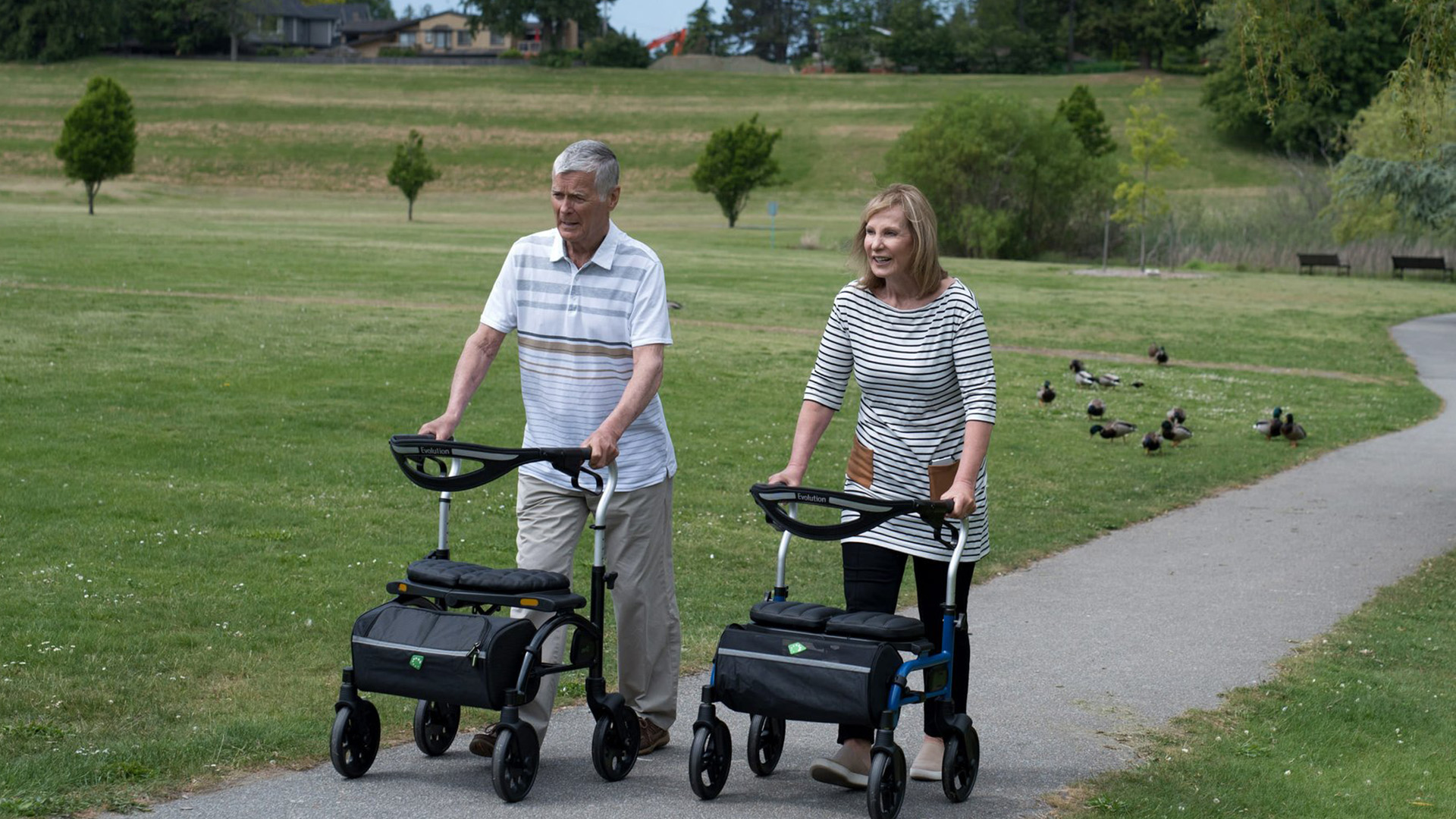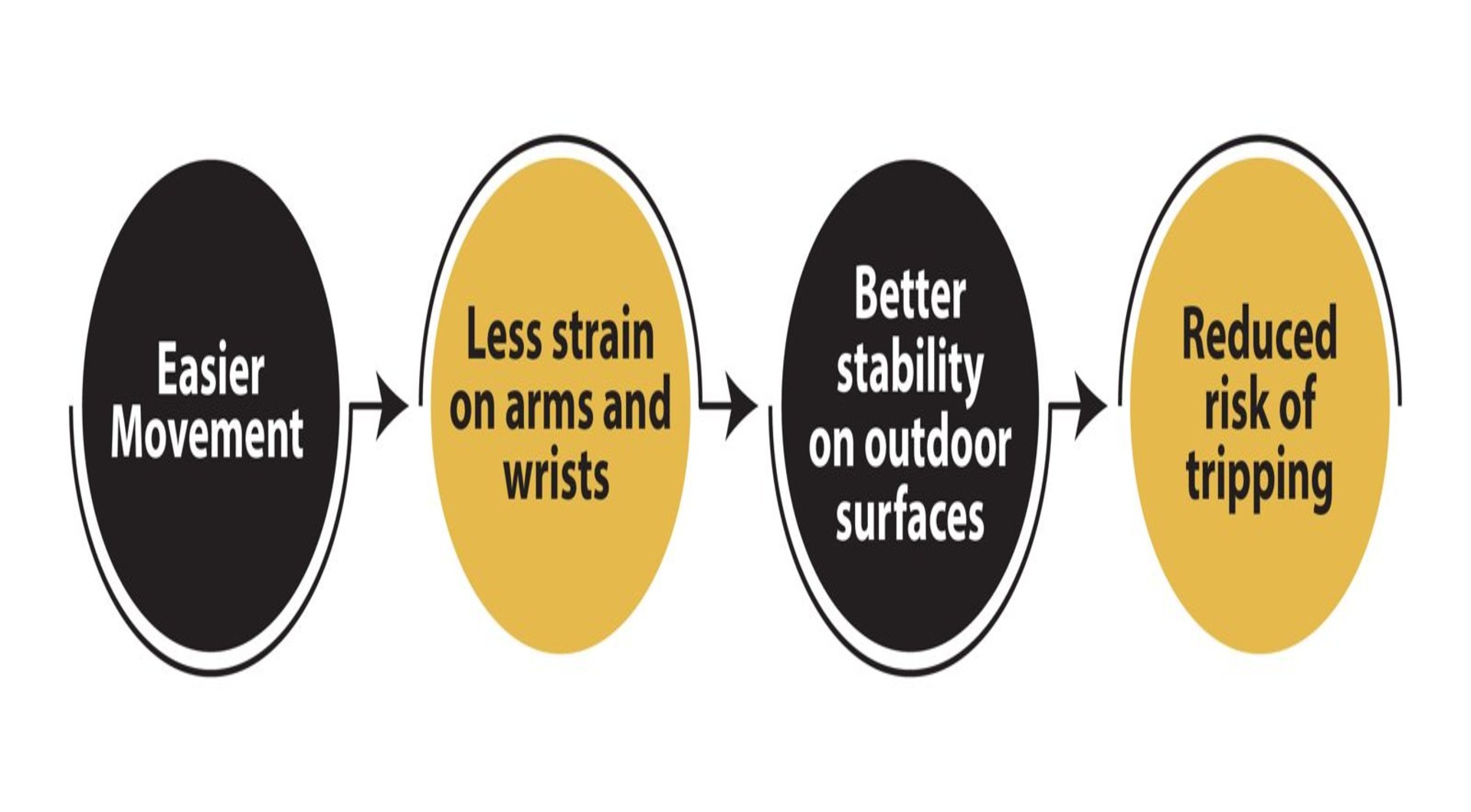Helpful Suggestions for Using a New Walker with Larger Wheels

Quick Summary
Walkers with larger wheels are excellent mobility aids for seniors, offering better maneuverability, stability, and ease of use on uneven terrain. This blog explores the benefits, tips for effective use, common mistakes to avoid, and answers to frequently asked questions about walkers with larger wheels.
Losing mobility is frustrating—especially when using a walker feels awkward or unsafe. Many seniors struggle with traditional walkers that get stuck on carpets or uneven ground, making movement difficult and exhausting.
If you're a senior (or a caregiver helping one) adjusting to a new walker with larger wheels, you need practical tips to move with ease and confidence. A poorly adjusted walker or incorrect walking technique can lead to discomfort, falls, or even injury.
The good news? With the right setup and techniques, a walker with larger wheels can offer smooth, effortless mobility—both indoors and outdoors. This guide will show you exactly how to use it safely, maximize stability, and navigate any terrain with ease. Let’s get started!
Table of Contents
Understanding Walkers with Larger Wheels
What Makes a Walker "Larger-Wheeled"?
Walkers with larger wheels typically have front wheels that are 6 inches or more in diameter. Some rollators (walkers with four wheels) have 8-10 inch wheels, making them even more suitable for outdoor use.
Key Differences Between Standard and Larger-Wheeled Walkers
|
Feature |
Standard Walker |
Larger-Wheeled Walker |
|
Wheel Size |
3-5 inches |
6-10 inches |
|
Terrain Suitability |
Best for smooth floors |
Handles uneven surfaces better |
|
Maneuverability |
Limited turning radius |
Easier to turn and push |
|
Speed & Comfort |
Slower, more effort needed |
Smoother movement, less strain |
Benefits of a Walker with Larger Wheels

A systematic review published in PubMed Central highlights that rollators improve spatio-temporal gait parameters in older adults, reducing the risk of falls by enhancing balance and stability during walking. However, their effectiveness depends on proper usage and individual needs.
Helpful Suggestions for Using a New Walker with Larger Wheels for a Senior
1. Choose the Right Walker for Your Needs
Not all large-wheeled walkers are the same. Consider these factors before purchasing:
- Wheel Size Matters – Choose 6-inch wheels or larger for smoother movement over uneven surfaces.
- Rollator vs. Standard Walker –Rollators (4 wheels) are for active seniors, while 2-wheeled walkers provide more stability. If you're unsure which type is best for you, check out our comprehensive guide on Types of Medical Walkers and Rollators.
- Height Adjustability – The walker should align with wrist level when standing upright.
- Weight Capacity – Ensure the walker can support your weight comfortably.
- Brakes (if using a rollator) – Look for easy-to-use hand brakes for safety.
|
Pro Tip: Test different models at a medical supply store to find the most comfortable fit! |
According to Physio-Pedia, incorrect height settings can lead to discomfort or strain.
2. Adjust the Walker Properly
An improperly adjusted walker can lead to poor posture, wrist strain, and falls. Follow these steps to adjust it correctly:
Step 1 – Stand Tall
Imagine standing in front of your walker, ready to take your first step. Instead of leaning forward, straighten your back, roll your shoulders back, and keep your head high. Your elbows should have a gentle bend—about 15 to 30 degrees—just enough to feel natural without straining. This posture helps you stay balanced and move with confidence.
Step 2 – Find the Right Handle Height
Let your arms hang loosely at your sides, then place your hands on the walker’s handles. They should be right at wrist level. Now, grip them lightly—do your forearms stay parallel to the ground? If not, adjust the height. A walker set too high can make you hunch while one too low can strain your back. Find the sweet spot where you feel steady and comfortable.
Step 3 – Check the Grips
As you hold onto your walker, pay attention to your hands. Do they feel sore or uncomfortable after a few minutes? If so, it’s time for an upgrade! Padded or contoured grips can make a world of difference, especially if you have arthritis or weak hands. A secure, comfortable grip means less strain and more confidence with every step. For more information, read about how supportive grips on walkers help seniors.
Step 4 – Test for Stability
Before heading out, take a moment to test your walker. If you have a rollator, squeeze the brakes to make sure they engage properly. Try them on different surfaces—smooth floors, rugs, or even the driveway. Give the wheels a quick check, ensuring they roll smoothly and aren’t loose. A stable walker isn’t just a tool; it’s your trusted companion for safe and steady movement.
|
Quick Fix: If you have back pain, adjust the walker’s height slightly higher to reduce strain. |
3. Practice Proper Walking Techniques
Using a walker incorrectly can increase the risk of tripping or falling. Here’s how to walk safely:
- Push the Walker Slightly Forward – Don’t shove it too far ahead.
- Step First with Your Weaker Leg – Follow with the stronger leg.
- Keep a Firm Grip – Hold the handles lightly but securely.
- Move slowly and steadily – Avoid rushing, especially on rough surfaces.
Avoid These Mistakes:
- Leaning too far forward (can cause loss of balance)
- Walking too far behind the walker (should stay between your legs)
- Lifting the walker unnecessarily—let the wheels do the work!
4. Be Cautious on Different Terrains
Larger wheels make it easier to navigate various surfaces, but each type requires special care:
Indoor Navigation Tips
- Carpets & Rugs: Secure loose edges or use gliders for a smooth roll.
- Hardwood & Tile: Move slowly to prevent slipping—rubber tips help!
- Narrow Spaces: Clear walkways to avoid bumping into furniture.
Outdoor Navigation Tips
- Sidewalks & Pavements: Look ahead for cracks or uneven areas.
- Curbs & Steps: Step close to the edge, lift the front wheels, then step up.
- Gravel & Grass: Use larger wheels (8-10 inches) for better traction.
|
Bonus Tip: Use walker skis or glide caps to improve movement on rough terrain! |
5. Learn How to Sit and Stand Safely
Many falls happen when sitting down or standing up. Follow these steps:
Sitting Down:
- Back up until your legs touch the chair.
- Lock the brakes (if using a rollator).
- Use one hand on the chair and one on the walker for support.
- Lower yourself slowly—don’t plop down!
Standing Up:
- Push up from the chair using your arms (not the walker handles).
- Grab the walker handles after you’re balanced.
- Take your first step only when steady.
|
Never Pull on the Walker to Stand! It can tip over, causing a fall. |
6. Use Accessories for Comfort & Convenience
Enhancing your walker with the right accessories can make daily movement more convenient and comfortable. A walker basket or pouch allows you to carry small essentials like your phone, keys, or a water bottle without needing to juggle them in your hands. If you find yourself walking in dimly lit areas, LED lights or reflectors can improve visibility, keeping you safer during early morning strolls or evening outings.
For those using a rollator, brakes and seat cushions are valuable additions—ensuring you have a secure way to stop and a comfortable place to rest when needed. Lastly, if your walker tends to drag or catch on the floor, consider walker glides or tennis balls on the legs. These help reduce friction, making each step feel smoother and requiring less effort as you move. With these simple yet effective add-ons, your walker can become an even more supportive and user-friendly mobility aid.
|
Pro Tip: Avoid hanging heavy bags on the walker—it can make it unstable! |
7. Strengthen Your Muscles for Better Stability
Regular leg and core exercises improve balance and make walker use easier. Try these:
|
Leg Strengthening Exercises: |
Arm & Grip Strengthening: |
|
Daily Goal: Try 10-15 minutes of simple exercises to build strength! |
8. Keep Your Walker in Good Condition
Regular maintenance prevents accidents and extends the walker’s lifespan.
Weekly Walker Checklist:
- Check the wheels – Ensure they roll smoothly and aren’t worn.
- Clean grips – Prevent dirt buildup for better comfort.
- Test brakes (if applicable) – Adjust if they feel loose.
- Inspect rubber tips – Replace if they look worn or uneven.
|
Pro Tip: Store the walker indoors to prevent rust or damage. |
A study by the Swedish Handicap Institute found that the consistent use of 4-wheeled walkers significantly improved mobility and reduced the need for additional home care among elderly women, emphasizing the importance of regular practice and maintenance.
Common Mistakes to Avoid While Using a Walker with Larger Wheels
- Leaning Too Far Forward – Many users tend to hunch over their walker, which can throw off balance and increase the risk of falls. How to avoid it: Stand upright, keeping your back straight and elbows slightly bent to maintain a natural posture.
- Not locking the Brakes Before Sitting or standing – Forgetting to engage the brakes can cause the walker to roll away unexpectedly. How to avoid it: Always double-check that the brakes are locked before you sit down or pull yourself up from a chair.
- Using the Walker on Uneven Surfaces Without Caution – Larger wheels make it easier to move across different terrains, but cracks, gravel, or curbs can still pose hazards. How to avoid it: Slow down on uneven ground and use ramps or smooth pathways whenever possible.
- Pushing the Walker Too Far Ahead – If the walker is too far in front of you, it can be difficult to control and may lead to instability. How to avoid it: Keep the walker close enough so you can comfortably grip the handles without overreaching.
- Ignoring Worn-Out Wheels or Loose Parts – Over time, wheels can wear down, and loose components can make the walker less stable. How to avoid it: Regularly inspect your walker for signs of wear and tear, tightening loose bolts and replacing damaged parts as needed.
- Holding the Handles Too Tightly or Too Loosely – Gripping too tightly can strain your wrists, while holding too loosely can make the walker harder to control. How to avoid it: Maintain a firm but relaxed grip, using padded grips if necessary for extra comfort.
- Relying Too Much on the Walker for Support – Walkers provide stability, but they shouldn't bear all your weight like a crutch. How to avoid it: Focus on using your legs to walk while the walker provides balance, and consider physical therapy if you need help strengthening your muscles.
Before purchasing a walker, it's important to understand if you're eligible for financial assistance. Read our guide to find out. Does Medicare Pay For Walkers For Seniors?
Research published in PubMed indicates that using a 4-wheeled walker can initially result in a slower and more inconsistent gait pattern. This highlights the importance of gradual adaptation and clinical follow-up during the initial stages of use.
Final Thoughts
Walkers with larger wheels offer significant advantages for seniors who need mobility support while maintaining an active lifestyle. The best walkers for seniors provide stability, ease of movement, and comfort, helping users navigate various terrains more smoothly.
By following proper usage techniques and avoiding common mistakes, seniors can enjoy increased independence and safety. Always consult a healthcare provider or physical therapist when selecting or adjusting a walker.
Frequently Asked Questions
References
The Walker Advisor is a team of experts dedicated to providing honest, research-based reviews of the best walkers and mobility aids for seniors. We gather real user feedback, both positive and negative, to help you make informed decisions. Our goal is to offer unbiased, transparent recommendations that ensure comfort, safety, and independence while meeting your unique needs and budget.
Welcome to The Walker Advisor Newsletter!
The Walker Advisor is committed to helping seniors and their families find the best mobility aids for safe and independent living.
Quick Links
Category
Copyright © 2025 The Walker Advisor All Rights Reserved
